Skiing is the act of gliding over snow on twin boards called skis. Many skiers enjoy the thrill of speeding down mountain trails. Others like the challenge of traveling long distances across flat or hilly terrain. Skiing is an extremely popular form of recreation. It is also an important competitive sport.
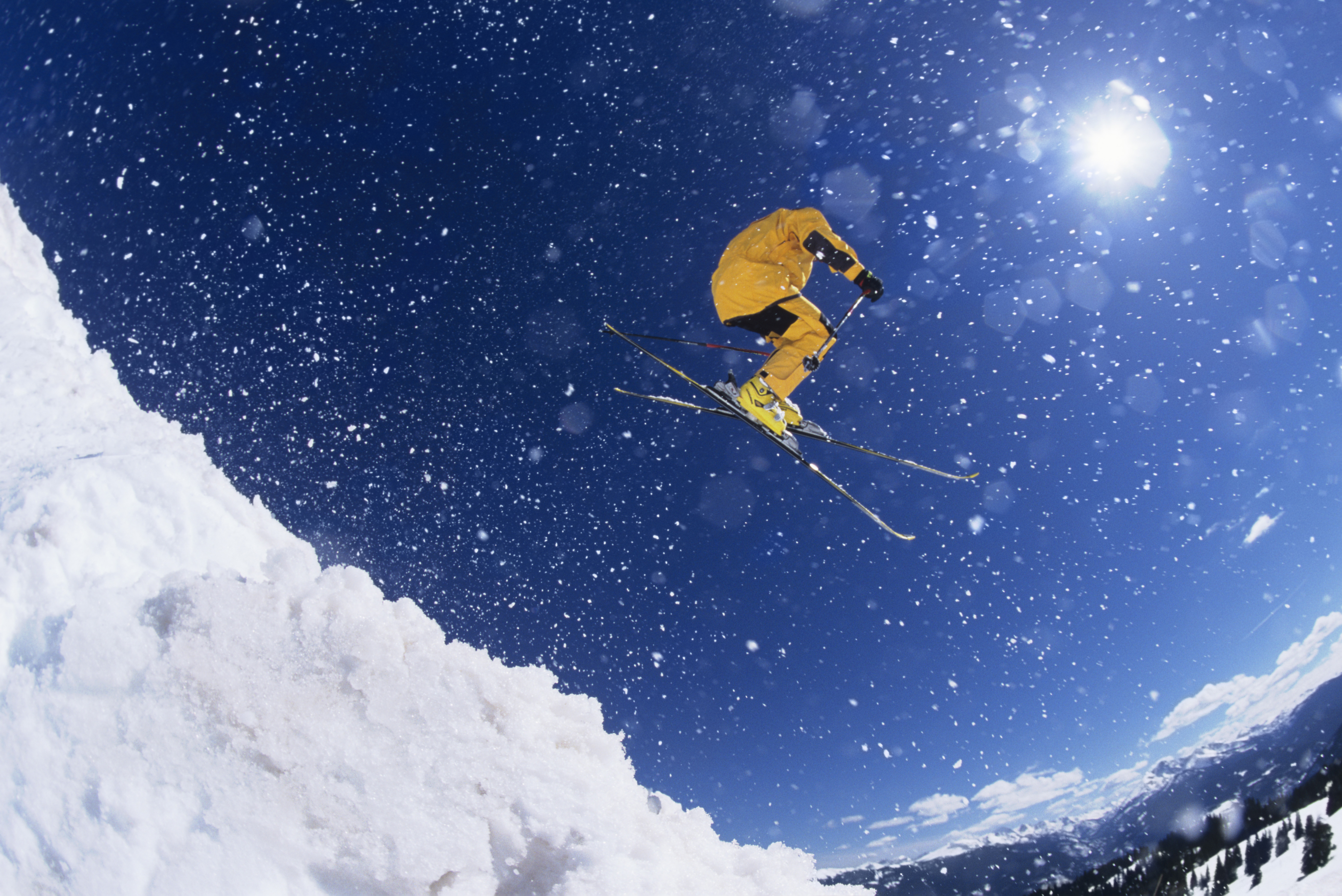
Types of skiing
There are three types of skiing: (1) Alpine, also called downhill, skiing; (2) Nordic skiing; and (3) freestyle, also called freeride, skiing. Related to skiing is snowboarding, which became popular in the 1980’s. Snowboarders slide down snow-covered surfaces on a single board.
The two most common and basic forms of skiing are Alpine skiing and cross-country skiing, a form of Nordic skiing. However, freestyle skiing continues to grow in popularity. The following discussion describes the basic techniques of each type. For information on skiing competitions, see the section Skiing as a sport. For information on snowboarding, see the Snowboarding article.
Alpine skiing
refers to skiing downhill. It is popular as a form of recreation and as a competitive sport. The term Alpine comes from Alps, the name of the mountain system in Europe where downhill skiing originated.
Loading the player...Skiing
Alpine skiing involves many techniques and moves. However, the four basic maneuvers of downhill skiing are (1) schussing, (2) traversing, (3) turning, and (4) stopping. Skiers carry a ski pole in each hand to help them keep their balance while making these maneuvers. The poles also aid skiers in walking and climbing.
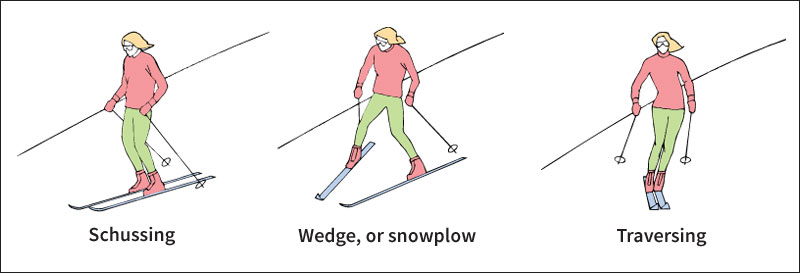
Schussing
is skiing straight down a slope without turning or stopping. It is the fastest form of skiing because skiers follow the _fall line—_that is, the most direct route to the bottom of the slope.
Traversing
is skiing at an angle to the fall line. Skiers use this maneuver to control their speed. They edge their skis while traversing to avoid slipping downhill sideways. Edging is done by tilting the skis at an angle to the slope so their metal edges bite into the snow.
Turning
is the most difficult part of downhill skiing. Turning enables skiers to change directions, control their speed, and avoid obstacles. The most elementary turn is the wedge, also called the snowplow. In this move, the skis are placed in a V position with tips (front ends) nearly touching and edged slightly inward. The wedge turn is also used to stop.
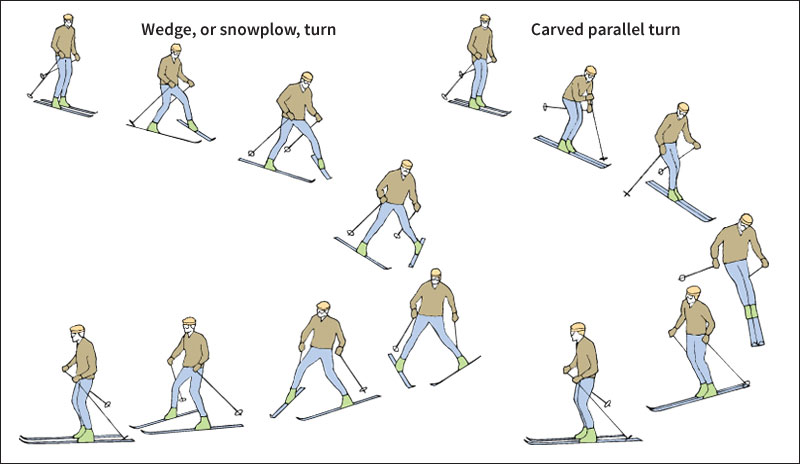
Students are taught to link wedge turns repeatedly and eventually match skis to make parallel and carved turns. The carved parallel is the most advanced turn. The skier rolls the knees over to one side, tipping the skis on their edges. Because modern skis are slightly curved and cut the snow in an arc, the skier simply maintains the skis on edge and follows the curve into the turn.
To halt their downhill progress, skiers make a sharp turn perpendicular to the hill and let the edges of the skis stop abruptly across the snow. This maneuver is called a hockey stop or skate stop because it is similar to the way ice skaters stop.
Nordic skiing
consists of (1) cross-country skiing, (2) telemark skiing, (3) backcountry skiing, and (4) ski jumping. The term Nordic refers to northern Europe—especially Norway, Sweden, and Finland—where cross-country skiing first developed as a practical means of travel in winter. Cross-country skiing is the most popular form of Nordic skiing, and ski jumping is a popular competitive sport. The following discussion describes these two forms of Nordic skiing.

Cross-country skiing
involves gliding across snow-covered terrain, going up and down hills. The basic movement is the diagonal stride, also called the kick-and-glide. The skier comes down on the forward ski with weight on the heel to make it slide. Then the skier makes a quick downward movement called a “kick” with the trailing ski, putting weight on the heel with the knee bent so the toe, knee, and skier’s nose are aligned on that ski. That ski then becomes the forward ski. The pole in the hand opposite the kick ski is set in the snow and pushed backward to further propel the skier forward.
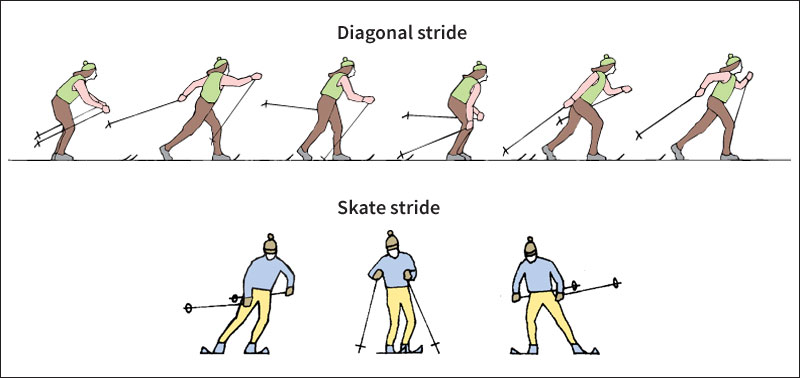
The skate is another movement in cross-country skiing. In the skate, one ski glides forward in a straight line, while the other is kicked out sideways and back in a skating motion to provide greater forward thrust.
To climb hills, cross-country skiers often use a movement called a herringbone, the reverse of an Alpine skier’s wedge. In a herringbone, the cross-country skier places the skis in a V shape with the tails (back ends) close together and the tips far apart to prevent backsliding. The skier then uses the inside ski edges to take small, choppy steps up the hill.
Ski jumping
is a highly specialized form of skiing in which a skier slides down a steep track and flies off a platform at the end. Ski jumping is performed mainly in competitions. Jumpers are evaluated on the distance of their leap and on their jumping style. Both portions count almost equally. Most ski jumping is performed on specially constructed 90-meter and 120-meter (295-foot and 395-foot) hills. The measurements refer to the typical distance a skilled jumper will fly from the take-off lip to landing. Larger 180-meter (590-foot) hills are called ski flying hills. They are not used in major international competition.
Freestyle skiing
is a form of skiing in which skiers perform stunts, maneuver through bumps, or do jumps and specialized tricks on the snow. There are five types of freestyle skiing: (1) moguls, also called bump skiing; (2) aerials; (3) skicross; (4) slopestyle; and (5) halfpipe.
Mogul or bump freestyle skiing
takes place on a steep slope with many moguls (moundlike elevations). Skiers try to ski quickly down the slope while performing such tricks as a 720 spin (two complete 360° rotations) off a jump in the middle of the course.
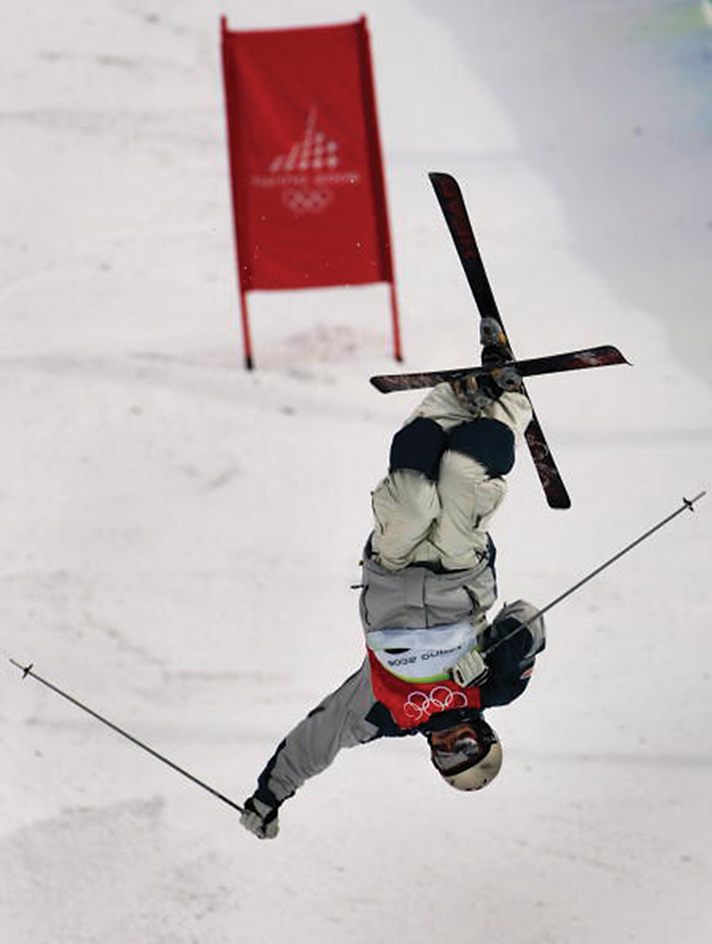
Aerials
resemble diving performed on skis. Aerial skiers ski down a steep hill and leap off a sharp platform, performing spins, flips, and other maneuvers before landing. They are judged both on the difficulty of the stunt performed and on how well they execute it.
Skicross
is a timed event in which skiers race down a course encountering natural terrain and artificial features, such as jumps and banks. Skicross resembles the snowboarding sport of snowboardcross.
Slopestyle
can be performed either on skis or on a snowboard. Athletes are judged on runs in which they perform tricks on a series of jumps, rails, boxes, and other features of a constructed course. Competitors must perform a wide variety of tricks to earn the highest scores.
Halfpipe
skiers perform on a halfpipe, a steeply banked structure made of snow with a flat bottom. Athletes are scored on tricks they perform while going up and down the walls or sides of the halfpipe.
Ski equipment and clothing
Standard ski equipment consists of (1) skis, (2) ski poles, (3) ski boots, (4) ski bindings, and (5) ski helmets. Skiers also wear special clothing to stay warm, dry, and comfortable.

The equipment differs for Alpine, Nordic, and freestyle skiing and for recreational and competitive skiing. Using the proper equipment and maintaining it in top condition helps skiers perform better and also reduces the chance of injury.
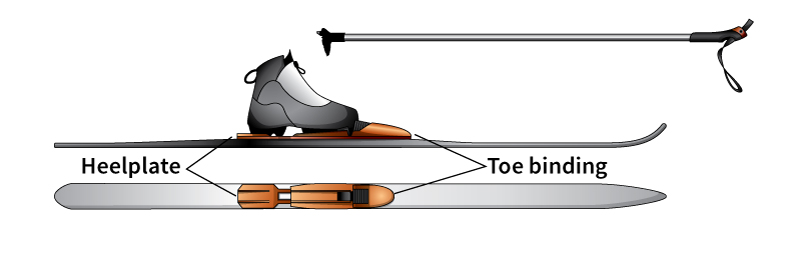
Skis
consist of two planks, or boards, with a tip, a midbody (center), and a tail. Skis can be made of a variety of materials, including fiberglass, plastic, metal, polyurethane foam, Kevlar (a strong synthetic fiber), and wood. Alpine and freestyle skis are constructed in a similar way and have metal edges along both sides to make turning easier. Cross-country skis are narrower and lighter than Alpine skis, and have no metal edges. Jumping skis are the longest and heaviest skis, usually measuring 100 inches (260 centimeters) in length.
Since the 1990’s, ski designs have changed dramatically. The design changes have made a major impact on Alpine skiing, especially among beginners or skiers with average skills. The first change was to shaped skis. Shaped skis featured lots of sidecut (inner curve of the ski). The result was a design that was broader at the tip and the tail and narrow at the midbody. Shaped skis were almost 4 to 8 inches (10 to 20 centimeters) shorter than traditional skis. Next came super-sidecuts, which had even more sidecut to help new skiers start turns more easily. Sidecuts and super-sidecuts replaced tall and narrow traditional skis.
In the early 2000’s, ski design made another leap forward with the invention of rocker skis. Rocker skis have a greater upward bend of the tip—or of both the tip and tail—than traditional skis do. In addition, rocker skis lack the slight arch or bend upward in the middle of the ski that traditional skis have. These design changes resulted in a shorter running length (portion of the ski that touches the snow), allowing skiers to make smooth turns at low speeds with little effort. The reduced contact length also makes steering and pivoting much easier. Beginners tend to learn faster with the rocker design and become confident on skis more quickly. Advanced skiers find maneuvering in deep powder snow conditions easier with rocker skis than with traditional skis.
Ski poles
are made of aluminum or composite materials. The shaft usually tapers from the top to a point at the bottom. A round or star-shaped piece of plastic called a basket is mounted about 3 inches (8 centimeters) from the point and prevents the pole from sinking too deeply into soft snow. Skiers hold each pole at the grip, a rubber or plastic handle at the top of the pole. The grip may be shaped like a sword handle. Or, it may have a strap that fits around the skier’s hand to prevent the pole from being dropped unintentionally. The strap also provides leverage when the pole is used to push across flat terrain. Poles for Alpine skiing should reach slightly above the skier’s waist. Cross-country poles resemble Alpine poles, but they are longer and their point is set at an angle to the shaft. The point grips the snow when the pole is swung forward and slips out of the snow easily when the skier glides beyond the pole.
Ski boots
provide support and warmth for the skier’s feet. Alpine boots consist of an outer shell made of rigid plastic and an inner boot made of a combination of foam, leather, vinyl, or other materials. They are generally fastened by buckles that run across the calf, instep, and forefoot. They sometimes have devices for adjusting flex resistance, a feature that also permits easier walking. All toes and heels on Alpine ski boots are identical in shape so they can be used in any binding. Cross-country boots are much lower in height and are more pliable to permit the foot to flex at the forefoot.
Ski bindings
are springlike devices screwed to skis to hold the boots firmly to the skis. If a skier falls, the bindings are designed to release the boot from the ski and thus help prevent lower body injuries. Alpine bindings secure the boot at both the toe and heel. They use a complex system of springs, cam rollers, and levers to ensure that skiers do not separate from their skis, except when injury might occur. Ski bindings also include ski brakes. The brakes act by forcing two prongs into the snow when a skier releases a binding. Ski brakes prevent a released ski from speeding down the slope and hitting other skiers.
Bindings on cross-country skis secure the boot only at the toe, keeping the heel free to lift during the kick phase of the diagonal stride. Many cross-country bindings also have a ridge plate behind the toe piece. The ridge plate fits into a groove in the sole of the boot to keep the skier’s foot from slipping off the ski.
Ski helmets
have become popular since they were introduced for recreational skiers in the 1990’s. Helmets provide added safety, comfort, and warmth. Helmets need to fit snugly around the head and should be fitted by an instructor or ski shop employee. Modern helmets are lightweight and feature vents, padding, and knobs to adjust the size. Helmets are designed to be worn with goggles, which protect skiers’ eyes from wind, sun, and obstacles.
Ski clothing
is made of fabrics that are designed to be warm, water-resistant, and comfortable. Clothing should fit snugly without restricting movement. Special features, such as Velcro closures, prevent snow from getting inside clothing. Most skiers dress in layers to create air pockets that trap heat. Alpine skiers generally wear warmer, heavier clothing than cross-country skiers because they produce less body heat while skiing. Alpine skiers normally wear a lightweight first layer designed to reduce moisture so the user stays dry. The second layer can be a fleece top (with a zip-down turtleneck option) or a sweater. The third, outer, layer consists of a jacket or parka and ski pants. Some skiers choose insulated jackets and pants, while others use a shell, with no insulating features. Necessary accessories include waterproof gloves or mittens, a hat or beanie that goes under the helmet, and a pair of thin ski socks.
Cross-country skiers dress in similar clothing but wear looser pants and tops that allow greater movement. In addition, cross-country skiers wear clothes with less insulation that can be removed easily as they generate body heat. Both Alpine and cross-country skiers wear goggles or sunglasses.
Skiing as recreation
Skiing is an extremely popular form of recreation in many countries. Millions of Americans and Canadians enjoy some form of skiing. Skiing is also popular in many European countries, as well as in Japan, Argentina, Chile, New Zealand, and Australia.
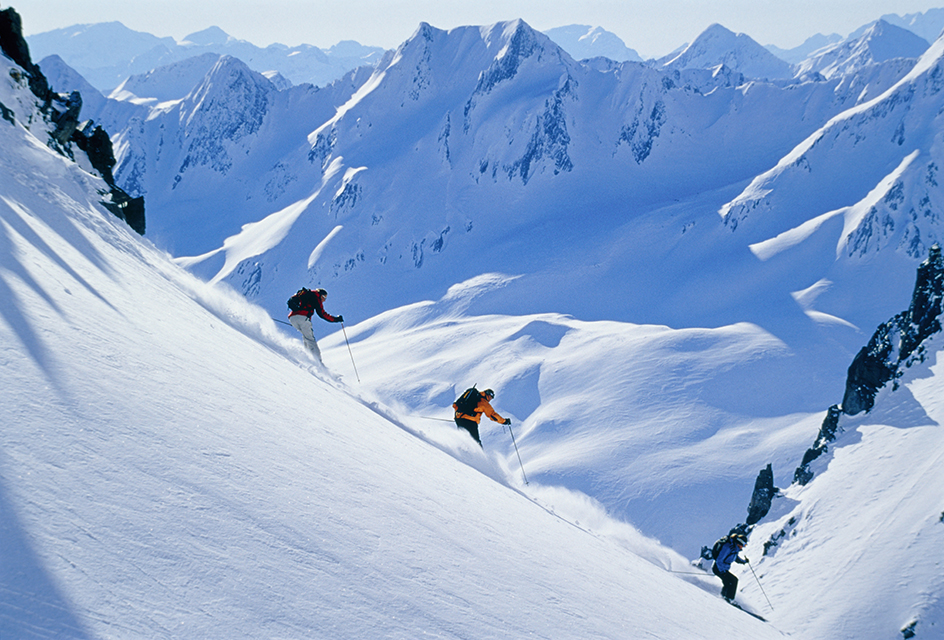
Ski area facilities.
There are thousands of Alpine ski areas in the world. Most of these areas are in Europe, the United States, South America, Japan, and Canada. Colorado is the most popular state for skiing in the United States, though New York has the most ski areas. All ski areas provide ski instruction, food, and such other services as shops that rent and sell ski equipment. Most mountain resorts have lodging on site or nearby. Ski areas are usually located in hilly or mountainous regions with heavy snowfall. However, snowmaking equipment also makes skiing possible in areas with cold weather but not necessarily abundant snow. Most ski areas in the United States have such equipment.
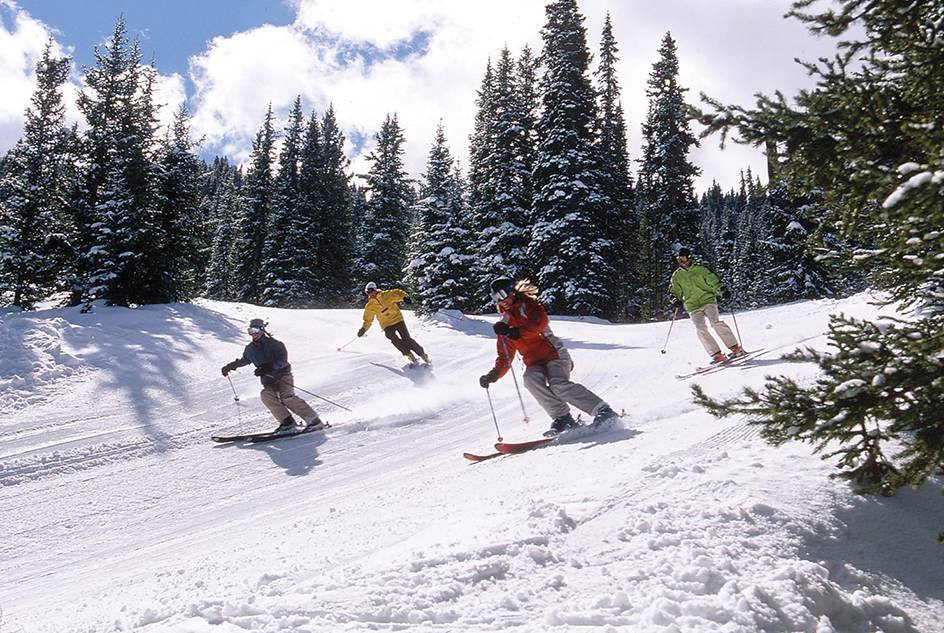
Many people enjoy cross-country skiing in parks, open fields, and other flat or hilly areas. In addition, many Alpine ski regions have paths for cross-country skiing called touring centers.
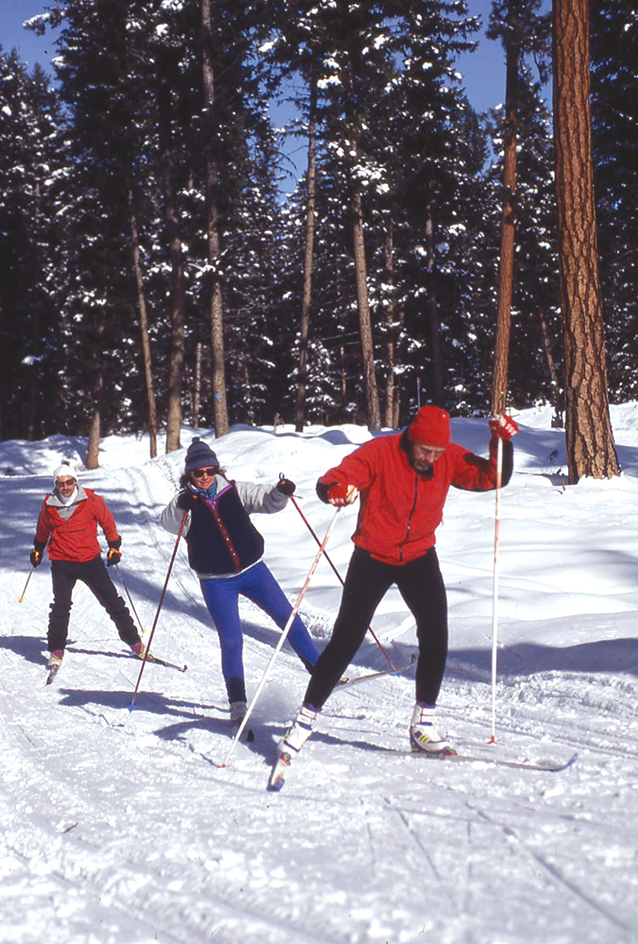
Ski trails
range from smooth, wide, gentle slopes for beginners to steep, narrow chutes that challenge experts. Some trails, especially those in the eastern United States, wander through wooded hillsides that require clearing before they become skiable. In Europe and South America, many slopes are located above the altitude at which trees stop growing. These trails permit skiers to wander across vast areas.
Skiers should choose trails suited to their ability and should not ski alone. Ski areas hire professional ski patrollers to aid injured skiers and enforce ski safety rules. Sometimes, volunteer members of the National Ski Patrol System handle these functions.
All Alpine ski areas have ski lifts. These devices transport skiers to the top of a slope. They use a rope or braided metal cable attached to a motor-driven pulley to carry skiers uphill by chair lift, tram, or gondola. Surface lifts move skiers uphill on the snow surface.
Snow conditions on trails vary greatly, depending on the weather, the ski area’s location, and the time of year. Some areas, such as those in the Rocky Mountains, generally receive light, dry snow called powder, which is ideal for skiing. Corn snow is the name for tiny pebblelike snow that occurs most often in spring. Packed powder and machine-groomed are the most common snow conditions and the easiest on which to maneuver. They result from skiers repeatedly passing over freshly fallen snow, or from snow being churned and compressed by tanklike grooming machines.
Ski instruction
shortens the learning period for beginners and adds to the safety and enjoyment of the experience. Advanced skiers often take lessons to improve their skills. All major U.S. ski areas have ski schools.
Most Alpine ski schools use the American Teaching Method (ATM). This method was developed by the Professional Ski Instructors of America (PSIA), the licensing body for U.S. ski instructors.
Beginners generally start on shorter skis. They first learn how to walk on skis and then how to get up from a fall. Then they learn sidestepping uphill, traversing across a hill, schussing down a gentle incline, and simple turns, such as the wedge. Later, they learn more difficult turns.
Skiing as a sport
The World Cup is the most important amateur skiing championship. World Cup titles are awarded annually to the men and women who have won the most points in a series of competitions in different kinds of races. The competitions are held in Northern Hemisphere countries from October to March.
Other major amateur competitions include the Alpine, Nordic, and freestyle events of the World Ski Championships and the Winter Olympic Games. The World Ski Championships are held every odd-numbered year. The Olympics are held every fourth year. The Fédération Internationale de Ski (FIS) governs all international amateur skiing competitions and also sponsors the World Ski Championships. United States Skiing governs all U.S. amateur ski competitions. In most competitions, distances are expressed in metric units. (One meter equals about 3.25 feet; one kilometer equals about 0.6 miles.)
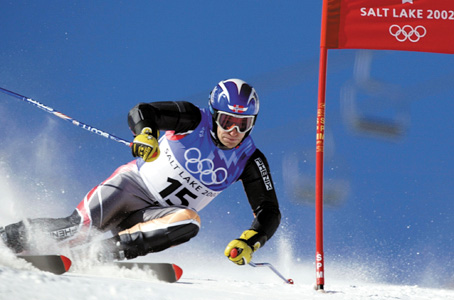
Professional skiing races take place throughout the world. Both amateur and professional skiers can earn prize money. Most top skiers also earn money from ski equipment and clothing manufacturers and other companies that sponsor them, based on how well they race.
Alpine competitions.
Most Alpine competitions are made up of one or more of five kinds of races: (1) the downhill; (2) the slalom << SLAH luhm >> ; (3) the giant slalom; (4) the super G; and (5) the parallel slalom. In the downhill, slalom, giant slalom, and super G, skiers race one at a time. In the parallel slalom, two skiers race at the same time on identical courses side-by-side. Skiers make two runs down similar courses in the slalom, giant slalom, and parallel slalom. In the downhill and super G, skiers make only one run.

The following discussion describes the races as conducted under FIS regulations, which most amateur competitions follow.
The downhill race
is a test of high-speed skiing. It is run on a course with a vertical drop of 800 to 1,000 meters for men’s events and 400 to 700 meters for women’s. As a safety measure, control gates are placed along the course. They direct skiers away from dangerous areas and force them to reduce their speed. Each gate consists of two flags that the competitors must ski between. Skilled downhill racers average 65 to 70 miles (105 to 113 kilometers) per hour and can complete the course in 11/2 to 2 minutes.
The slalom
challenges skill in high-speed turning. The course is marked by numbered gates that each competitor must pass through in proper order. The gates are set so that the racers must make many turns, skiing in a zigzag fashion. 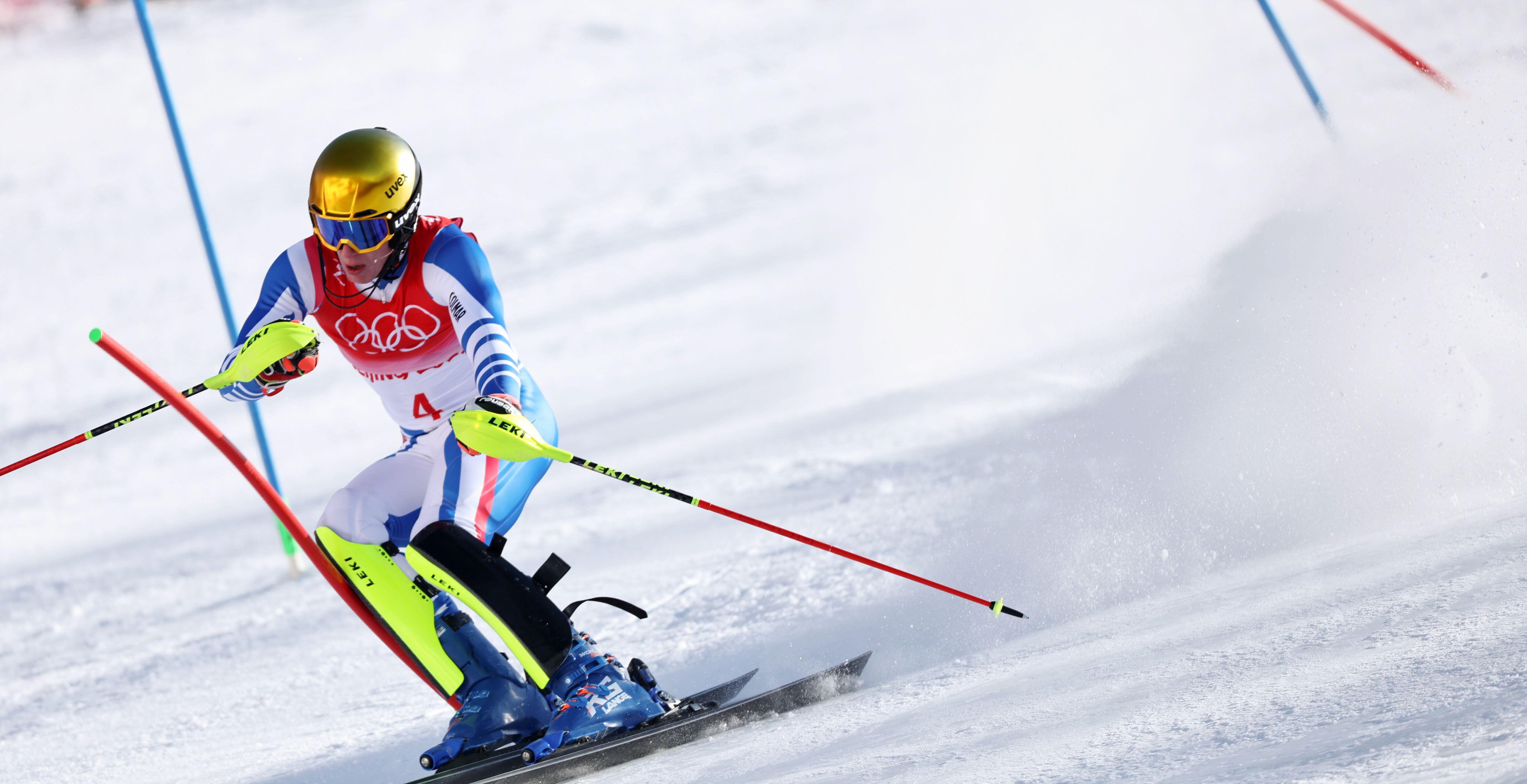
The giant slalom
is a test of high-speed traversing. It combines elements of the downhill race and the slalom.
The super G,
formerly called the super giant slalom, is a cross between the downhill race and the giant slalom.
The parallel slalom
has two or more courses that resemble a small slalom course. The courses are from 6 to 7 meters apart. Most professional races are parallel slaloms or parallel giant slaloms.
Combined
competitions consist of a downhill race and a slalom. The two events are always held in the same location but often take place on different days.
Nordic competitions
consist of five events. They are (1) cross-country races, (2) cross-country relays, (3) jumping competitions, (4) the Nordic combined, and (5) the biathlon.
Cross-country
races are conducted on courses that are about one-third uphill, one-third downhill, and one-third flat. In classical races, only the diagonal stride is permitted. In freestyle events, the faster skate stride may be used. In major meets, the men’s cross-country courses generally range from 10 to 50 kilometers long. Women’s courses are from 5 to 30 kilometers. The skier with the fastest time wins.
Cross-country relays
are team competitions in which each member of the team races an equal distance. For example, teams of four compete in the 40-kilometer men’s relay in the Winter Olympics, and each member skis 10 kilometers. The first skiers from each team start at the same time in a mass start. The first skier across the finish line wins.
Jumping competitions
are popular spectator events in competitive skiing. Competitors receive points for both the length of their jump and their jumping style. The skier with the most points wins. A jumper may outdistance the other competitors but lose the event because of a shaky landing or other flaw in style. Jumpers may fly more than 90 meters. Often, wind may affect a jumper.
The Nordic combined
consists of both cross-country skiing and ski jumping. Competitors race over a 10-kilometer course and make several ski jumps. They receive points for each activity, and the skier with the most points wins the event.
The biathlon
combines cross-country racing and riflery. In most individual competitions, participants ski over a course 10 or 20 kilometers long on which targets are set at different points. The skiers must shoot at the targets from the standing and prone (lying down) positions and are penalized for every miss. The skier who completes the course in the shortest time wins. In the biathlon relay, four skiers each race 7.5 kilometers.
Freestyle and other types of competition.
During the late 1900’s, a greater variety of competitions were introduced using Alpine skis. Freestyle skiing became a medal sport in the Olympic Winter Games with the introduction of moguls competition in 1992. Moguls competitors are required to perform tricks and jumps. Aerial freestyle competitors are judged on jump takeoff, form, and landing. Skiercross or ski cross begins with athletes racing individually down a course. The athletes with the best times are then divided into groups of four and compete to determine who advances to the next round. The two top finishers continue to compete, while the losers are eliminated, until there is one winner. In extreme or freeskiing events, skiers soar down exceptionally steep and rocky courses one at a time. Contestants are judged on their skill and the variety and difficulty of the tricks they perform.
History
Skiing began thousands of years ago in northern Europe and Asia. Norwegian immigrants introduced skiing into the United States in the mid-1800’s.
The development of modern skiing
began about 1850, when a Norwegian named Sondre Norheim invented the first stiff bindings. The bindings held the skis more securely than leather straps did and so provided greater control. With his improved bindings, Norheim developed new turning maneuvers.
In 1896, Mathias Zdarsky of Austria introduced the technique of pushing one ski at an angle to the fall line to control speed. During the early 1900’s, Hannes Schneider, who lived in the Arlberg region of Austria, developed new stopping and turning maneuvers based on Zdarsky’s technique. Schneider organized these maneuvers into the first formal method of ski instruction. It became known as the Arlberg technique and forms the basis of most modern skiing techniques.
During the early 1900’s,
skiing became an increasingly popular competitive sport. Switzerland held the first organized slalom race in 1921. In 1924, Nordic competitions were included in the first Winter Olympic Games. The competitions now called the World Ski Championships began in 1925. In 1936, Alpine events became part of the Winter Olympics.
The invention of ski lifts during the early 1930’s led more and more people to take up recreational skiing. To accommodate the increasing number of skiers, many ski areas and resorts were expanded or developed in the United States, Canada, and Europe.
The middle and late 1900’s.
Early in World War II (1939-1945), Finland used ski patrols to resist Soviet invaders. In 1945, U.S. Army 10th Mountain Division ski troops fought a decisive battle with German forces in the mountains of Italy.
After the war, skiing began a new boom. In 1948, Gretchen Fraser became the first American to win an Olympic gold medal for skiing. The big star of the 1950’s was Toni Sailer of Austria, who won three gold medals in the 1956 Olympics. The superstar of the 1960’s was France’s Jean-Claude Killy. He won the World Cup in 1967 and 1968 and three gold medals in the 1968 Olympics.
The publicity given skiing champions and the coverage of ski meets on television and in the press stimulated interest in recreational skiing. In the 1960’s, about 400 ski resorts were built in the United States.
Ingemar Stenmark of Sweden dominated skiing during much of the 1970’s and 1980’s. Stenmark finished his career with a record 86 World Cup victories. Annemarie Moser-Proell of Austria was the top woman World Cup skier of that period. Alberto Tomba of Italy was the top Alpine skier from the mid-1980’s to the late 1990’s.
American skier Phil Mahre won World Cup titles in 1981, 1982, and 1983. Picabo Street became the most successful American woman skier of the 1990’s, winning medals in the 1994 and 1998 Winter Olympic Games. Bjørn Dæhlie of Norway, who began skiing in the late 1980’s, ranks as the most successful cross-country skier in history. Dæhlie won more than 40 World Cup races and a record eight gold medals in the Winter Olympics.
Skiing today.
The Alpine World Cup remains the leading skiing competition. It was dominated by an Austrian team led by Hermann Maier in the early 2000’s. Bode Miller of the United States won World Cup titles in 2005 and 2008. American Lindsey Vonn won women’s World Cup titles in 2008, 2009, 2010, and 2012. The major Nordic teams traditionally come from such countries as Norway, Russia, and Sweden. Americans have dominated freestyle skiing.

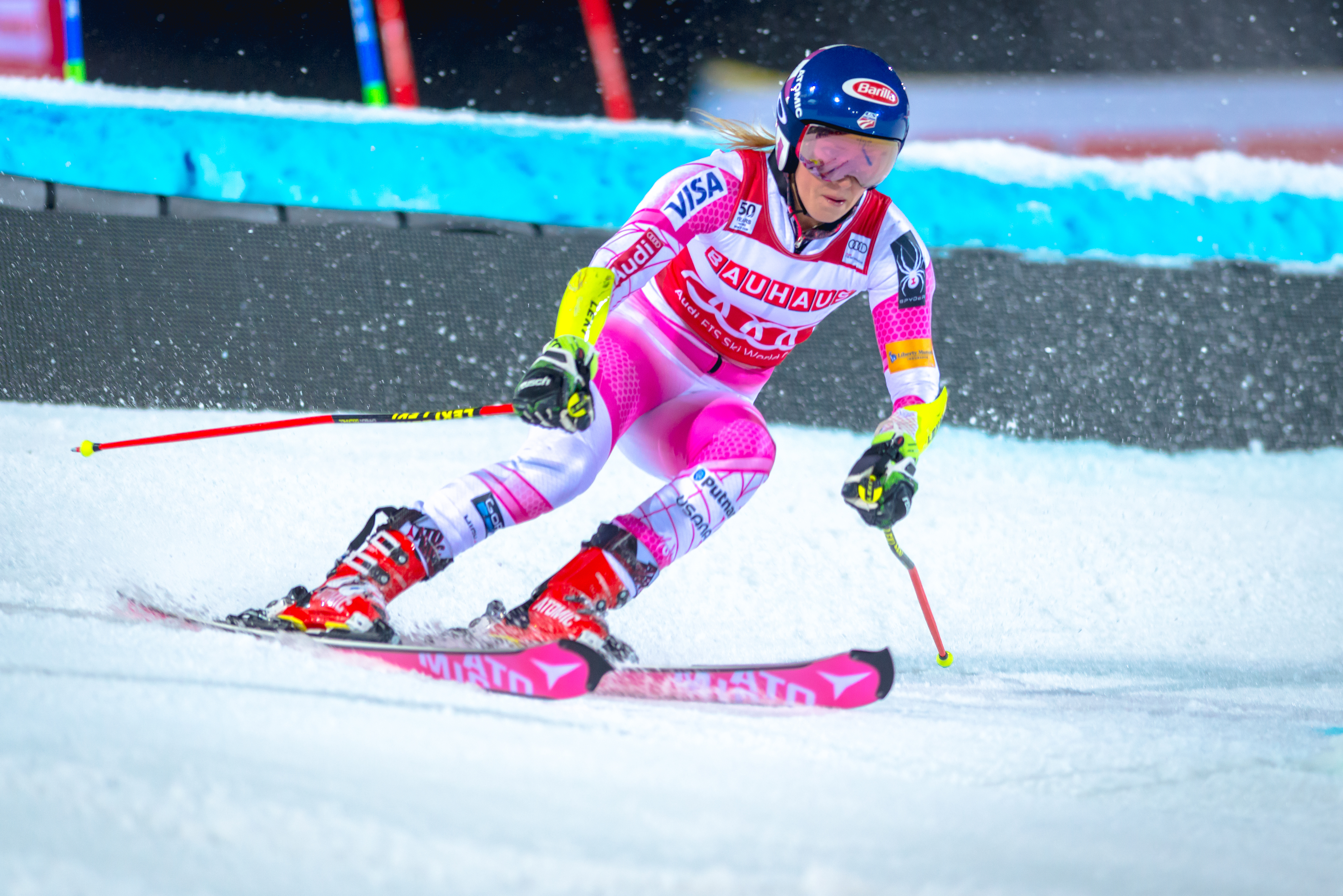
While skiing remains a popular sport in Europe and North America, the number of recreational participants has not risen since the mid-1980’s. Few new ski areas have been built since the early 1980’s because of the cost of construction and opposition from conservationist groups. Many small ski areas have closed, unable to afford the large expense for state-of-the-art ski lifts and snowmaking and grooming equipment. Many large ski areas, however, have doubled and tripled in size. Most of the largest North American ski areas are now owned by a few corporations.
